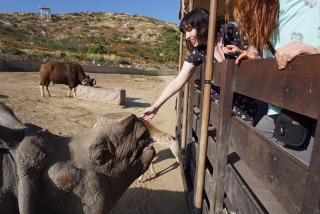Camera traps have been a key part of the conservation toolkit for decades. Remotely triggered video or still cameras allow researchers and managers to monitor cryptic species, survey populations, and support enforcement responses by documenting illegal activities. Increasingly, machine learning is being implemented to automate the processing of data generated by camera traps.
A recent study published showed that, despite being well-established and widely used tools in conservation, progress in the development of camera traps has plateaued since the emergence of the modern model in the mid-2000s, leaving users struggling with many of the same issues they faced a decade ago. That manufacturer ratings have not improved over time, despite technological advancements, demonstrates the need for a new generation of innovative conservation camera traps. Join this group and explore existing efforts, established needs, and what next-generation camera traps might look like - including the integration of AI for data processing through initiatives like Wildlife Insights and Wild Me.
Group Highlights:
Our past Tech Tutors seasons featured multiple episodes for experienced and new camera trappers. How Do I Repair My Camera Traps? featured WILDLABS members Laure Joanny, Alistair Stewart, and Rob Appleby and featured many troubleshooting and DIY resources for common issues.
For camera trap users looking to incorporate machine learning into the data analysis process, Sara Beery's How do I get started using machine learning for my camera traps? is an incredible resource discussing the user-friendly tool MegaDetector.
And for those who are new to camera trapping, Marcella Kelly's How do I choose the right camera trap(s) based on interests, goals, and species? will help you make important decisions based on factors like species, environment, power, durability, and more.
Finally, for an in-depth conversation on camera trap hardware and software, check out the Camera Traps Virtual Meetup featuring Sara Beery, Roland Kays, and Sam Seccombe.
And while you're here, be sure to stop by the camera trap community's collaborative troubleshooting data bank, where we're compiling common problems with the goal of creating a consistent place to exchange tips and tricks!
Header photo: Stephanie O'Donnell
Wildlife Conservation Research Unit (WildCru)
Conservation Scientist

- 0 Resources
- 0 Discussions
- 4 Groups
Article
Today we're celebrating the #Tech4Wildlife Photo Challenge by shining a spotlight on one of our favorite WILDLABS collaboration success stories: the BoomBox! This collaboration between Dr. Meredith Palmer, Jacinta ...
26 February 2021
Last year, Tim van Deursen and Thijs Suijten shared their new "Hack the Poacher" system with us, presenting a unique way to detect poachers in real-time within protected national parks. Read on to learn about their...
29 January 2021
In this case study from WWF's Northern Great Plains Program, Black-footed Ferret Restoration Manager Kristy Bly discusses how infrared FLIR cameras help teams detect and monitor the highly endangered black-footed...
19 January 2021
WILDLABS member Meredith Palmer shared this great course module based around Snapshot Serengeti camera trap data, and developed for university biology courses. This material is ideal for introductory level biology...
25 November 2020
Community Announcement
WILDLABS is celebrating its five year anniversary! Throughout the rest of 2020, we'll be sharing articles, community features, and case studies showcasing the incredible projects, collaborations, and successes that this...
17 November 2020
To celebrate the first Black Mammalogists Week (starting Sunday, September 13th), we talked to four of the amazing Black scientists behind this event! Find out what they had to say about their favorite (and most...
10 September 2020
Today, WWF conservation engineering intern Ashley Rosen shares insight into the process of redesigning a camera mount for FLIR thermal cameras used by rangers in the fight against poaching. Ashley's design will become a...
24 August 2020
Our first season of Tech Tutors may have wrapped, but the connections and collaborations from these episodes are still going strong! Today, we're sharing Tech Tutor presenter Laure Joanny's recap of the most important...
20 August 2020
Since 2016, ZSL’s Instant Detect team have been working on improving metal detecting sensors for anti-poaching. The team believe that using metal detecting sensors will provide a highly targeted detection of potential...
10 August 2020
In this case study from herpetologist Emily Taylor, we learn about the best methods and gear used to track snakes, lizards, and other reptiles and amphibians via radio-telemetry, and how these techniques have changed...
31 July 2020
This exciting news article about The Global Wetland Project's FishID platform discusses the latest improvements and developments in using deep learning to identify individual fish species underwater. In addition to...
28 July 2020
Article
In this article from BearID Project, Director and Software Developer Ed Miller walks us through using their application to identify individual bears from photographs. Ed shows us how to easily use BearID remotely in the...
21 July 2020
June 2025
July 2025
58 Products
Recently updated products
4 Products
Recently updated products
| Description | Activity | Replies | Groups | Updated |
|---|---|---|---|---|
| Our lowcost Pi model (Wildlife Security Innovations thermal camtrap) thermal wild camera is multi-camera. Recording 24/7 from both the thermal and visible RGB camera modules... |
|
Camera Traps, Data management and processing tools | 1 day 11 hours ago | |
| True, the US ecosystem is a challenging space right now, for basically all sectors. We should not let the US chaos prevent us from engaging with opportunities in other... |
|
AI for Conservation, Camera Traps, Connectivity, Drones, Emerging Tech, Ethics of Conservation Tech, Marine Conservation, Sensors | 1 month 1 week ago | |
| We have spent the past 9 months taking the lessons learnt from the AMI system to build an automated moth monitoring system... |
|
Autonomous Camera Traps for Insects, Camera Traps | 1 week ago | |
| Lively and informative discussion, I would very much like to contribute if there is some active development work with regards to this. I have recent experience with using... |
+31
|
Data management and processing tools, Camera Traps, Software Development | 1 week 5 days ago | |
|
|
Latin America Community, Acoustics, AI for Conservation, Camera Traps, Drones, Early Career | 3 weeks 6 days ago | ||
| @LukeD, I am looping in @Kamalama997 from the TRAPPER team who is working on porting MegaDetector and other models to RPi with the AI HAT+. Kamil will have more specific questions. |
|
AI for Conservation, Camera Traps | 3 weeks 6 days ago | |
| Hi Ștefan! In my current case, I am trying to detect and count Arctic fox pups. Unfortunately, Arctic fox does not seem to be included in the training data of SpeciesNet but... |
+16
|
AI for Conservation, Camera Traps | 4 weeks ago | |
| Interesting. Thanks for the explanation. Nice to hear your passion showing through. |
|
AI for Conservation, Camera Traps, Data management and processing tools, Open Source Solutions, Software Development | 1 month ago | |
| Weeks with continuous inference would require a pretty big battery. I expect you would need some kind of customisation and maybe quite a bit of compromise to last weeks and on a... |
|
Camera Traps | 1 month ago | |
| 📸 Do you use camera traps in your work? Take part in our survey!Hi everyone! I’m currently a final-year engineering... |
|
Camera Traps, AI for Conservation, Data management and processing tools, Open Source Solutions, Software Development | 1 month ago | |
| That's great! |
|
Camera Traps | 1 month ago | |
| Yes, I know about this big limitation,As far as I know they are working to increase the coverage available for this solution.For trusted developers, there are more regions... |
|
Connectivity, Camera Traps | 1 month 2 weeks ago |



























